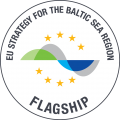A multi-factorial analysis in the BSR
One of the sub-projects under RETROUT addressed the challenge of improving the ecological status of river courses in the BSR, potentially leading to larger fish stocks which is a prerequisite for a growing fishing tourism industry. This sub-project aimed to finally propose “Best Practice Solutions” for efficient and sustainable restoration measures for such rivers with a focus on sea trout. The implementation of river restoration measures (mainly habitat restoration and addressing migration barriers) in selected rivers was evaluated, with an aim to analyze successful and failed/non-realized river restoration projects and identify the underlying factors leading to such outcomes. The study was based on a qualitative analysis of data collected from past river restoration projects planned and/or implemented in potential sea trout rivers flowing to the Baltic Sea. Data from a total of 96 river restoration projects located in 73 rivers in the Baltic Sea Region were collected through a survey conducted in all Baltic Sea Region countries (except Germany). 15 river restoration projects were selected for detailed interview-based case studies.
From this study it emerges that the factors important for success of river restoration projects can be divided into two broad categories: context-based and process-based factors. The former concern the context in and about which the project is designed and implemented, while the latter concerns the process adopted for planning, designing, implementing and undertaking the post-implementation phases of the project. Factors within each of these categories are equally important in deciding the fate of the project.
The identification of these factors has important implications for defining the Do’s and Don’ts with regard to best river restoration practices. First and foremost, a river restoration project must always be developed on the basis of a holistic analysis of the ‘context’. This should consider four important dimensions: Ecological, Political, Economic, and Social and cultural. The contextual factors set the stage for the project, while the ‘process-based’ factors determine how well the project will be planned, designed, implemented and followed-up in post-implementation phases. The process-based factors should consider following dimensions: Technical, Project processes, Social, and Financial planning and resources.
The study showed that river restoration projects classified as ‘successful’ have strong roots in one or more of the above factors, while those that have failed to be implemented or have failed in terms of results have neglected more than one of the crucial factors listed above. If river restoration efforts in the BSR are to bear fruits and lead to improvement in the stocks and status of sea trout and other salmonids, it is important to overcome these weaknesses and adopt only the Best possible Practices.
The lead author of the report is Dr Nandita Singh, Water Centre for Innovation, Campus Roslagen (UCV-CR), Norrtälje, Sweden.
An extended summary of the report is found here


